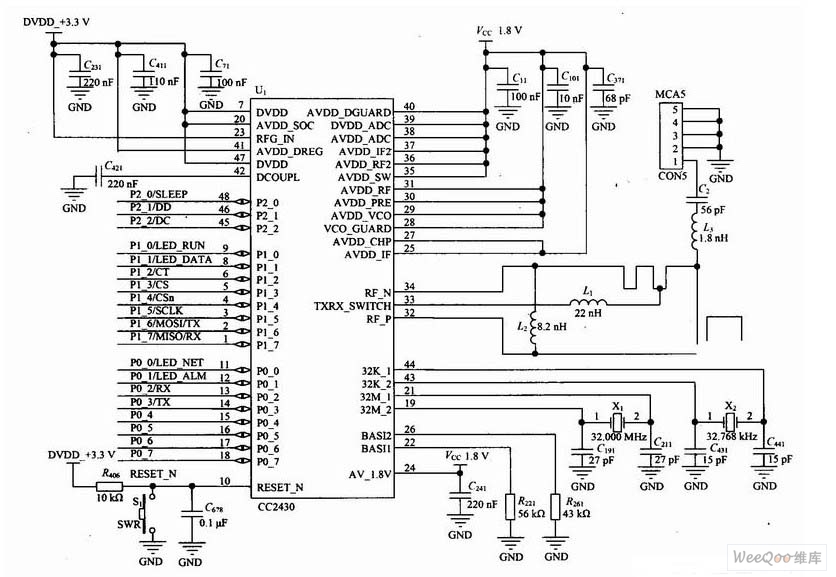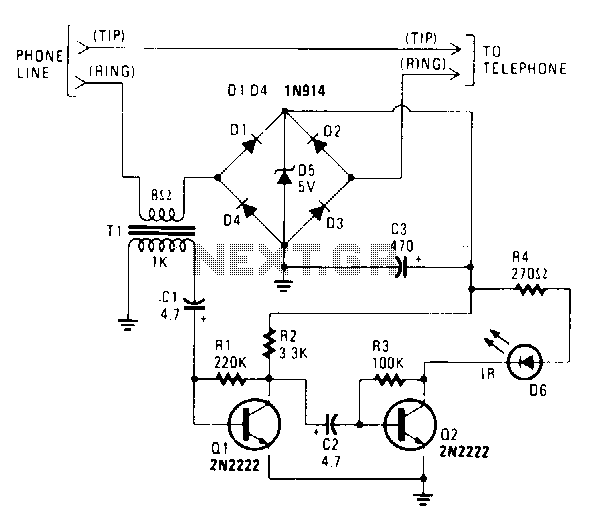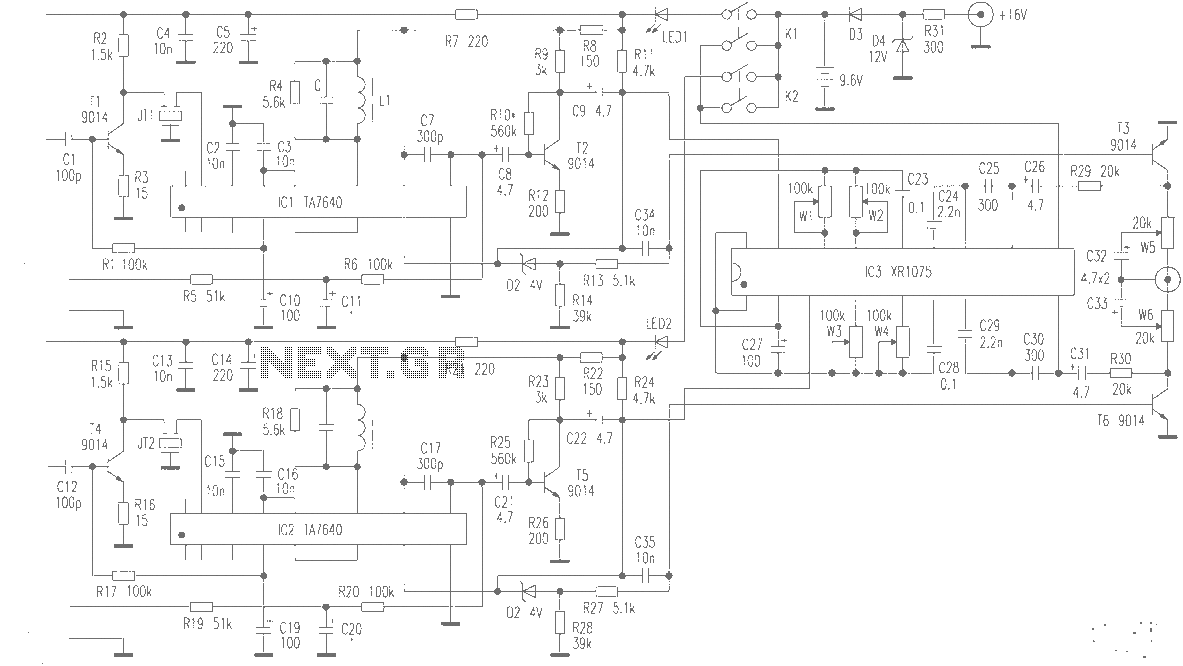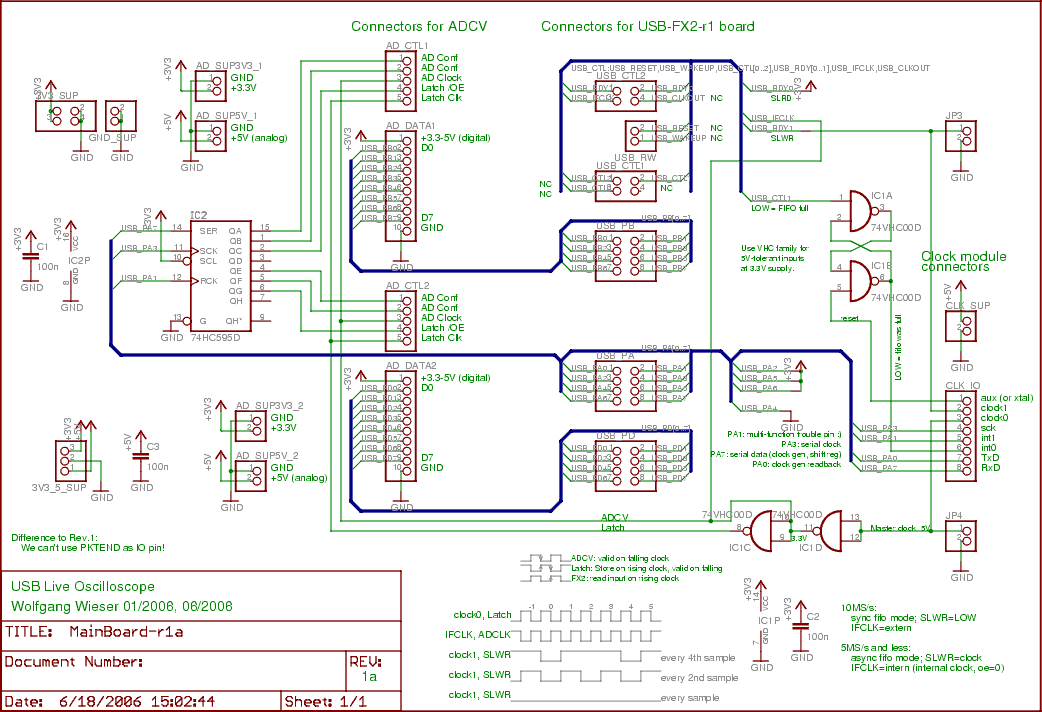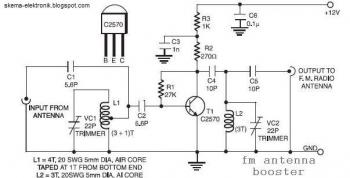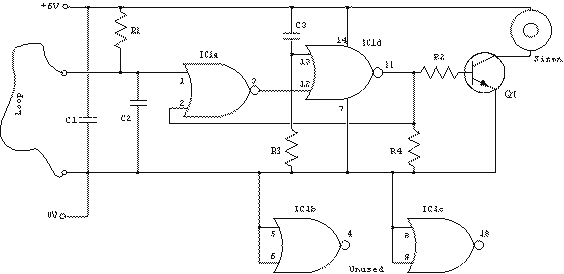
Live Wire Antenna
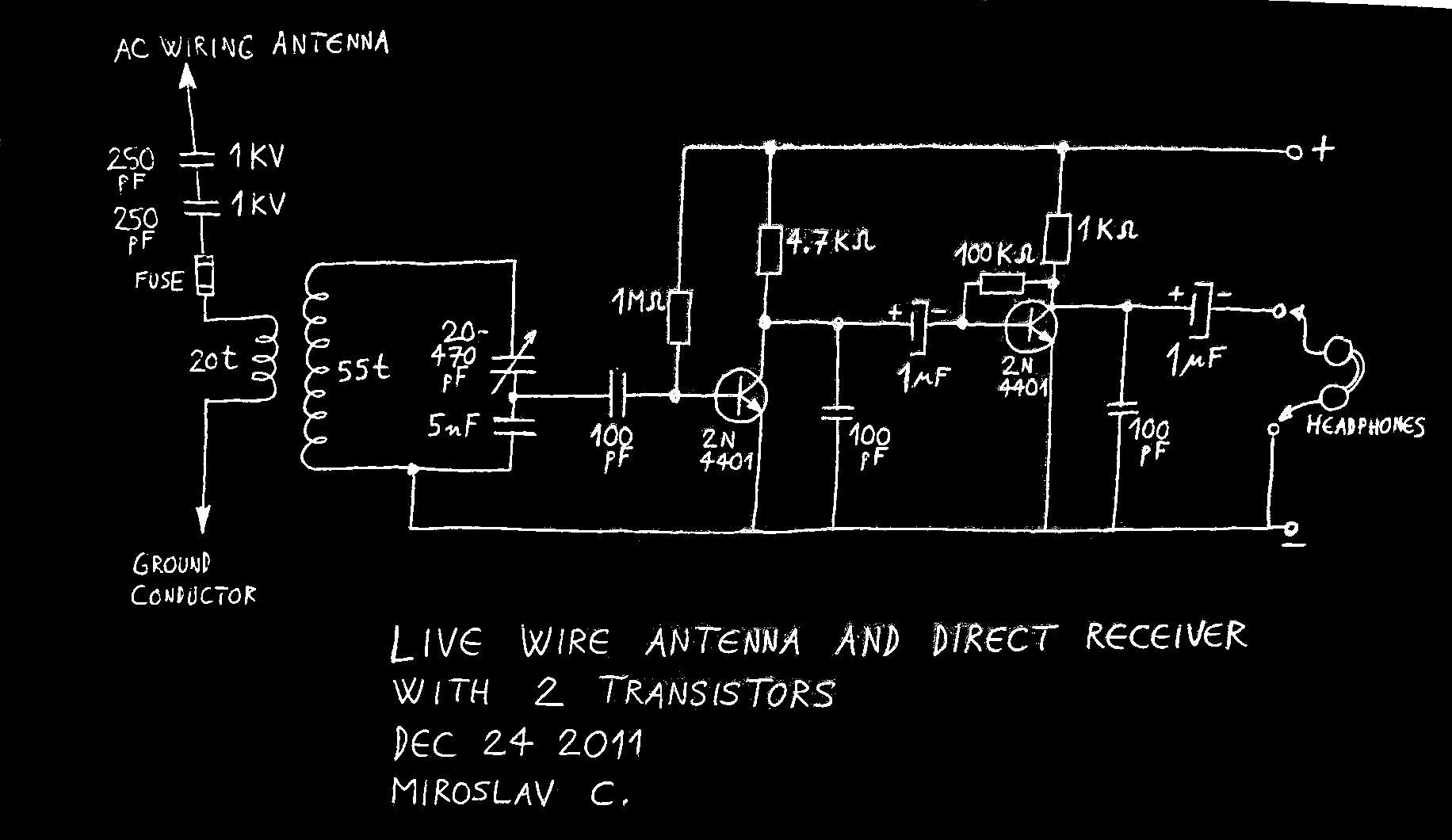
Using live or neutral wire in AC household wiring as a receiving antenna is feasible only with a high-voltage capacitor inserted between the receiver antenna terminal and the live or neutral wire. This AC wiring antenna solution is often considered a last resort when no other antenna can be installed due to space constraints. The ground conductor can serve as an Earth ground. Older recommendations suggest using a cold water pipe as a ground connection, though its practicality and legality may be questionable today. It is advised to use a single high-quality capacitor for antenna connection rather than two in series. A small two-transistor medium-wave AM receiver was constructed with a headphone output for testing this system. To minimize loading on the main LC tank circuit, high frequency is derived from a capacitive divider consisting of a variable capacitor and a 5 nF capacitor. The voltage drop across the larger capacitor is smaller due to its lower capacitive reactance (Xc = 1/(2πfC)). As higher frequencies are received, the voltage from the main LC circuit decreases since the smaller capacitance of the variable capacitor takes on more of the divider voltage. This effect is deemed unimportant for the relatively narrow tuning range of medium-wave frequencies, which is approximately 700 kHz to 2800 kHz. To ensure safety and protect the receiver, two high-voltage capacitors are used in series, with the antenna coil galvanically isolated from the rest of the circuit and a fuse included. If a high-voltage spike penetrates both capacitors rated at 1 kV, the fuse will blow. Should the fuse fail, the antenna coil, made from 0.3 mm diameter wire and consisting of 20 turns, would burn out without causing further damage to the receiver or the user. Initial tests used a 1 m wire antenna without a ground connection, successfully receiving four nearby AM stations, three of which were identified for testing. Subsequent tests involved connecting the live wire antenna to an AC outlet, the neutral wire antenna to an AC outlet, and finally using a power cable antenna not plugged into the outlet. The testing video demonstrates the live wire as an antenna, which alters the frequency of the main receiver LC circuit, necessitating retuning for optimal sound output. The sound quality is weak as it comes solely from the headphones, making it difficult to hear weaker stations in the video. A fourth station, 820 kHz CHAM, was received and understood but not used for testing; it was located 15 km from the transmitter, producing 30 mV at the headphones with a transmitter power of 50 kW. Measurements with the live wire antenna and an Earth connection to a grounded cable conductor (with the cable unplugged) showed that a regular 6-foot (1.8 m) power cable, even when not plugged in, provided surprisingly good reception, outperforming the single 1 m wire. This may be attributed to the antenna and ground wire being of equal length, effectively creating a crude non-resonant dipole antenna. The live and neutral wire antenna connections yield a substantial signal, indicating that this method is a viable alternative when no other antenna is available. The primary challenge encountered is a 60 Hz hum that obscures weaker stations, which can potentially be mitigated by reducing the number of turns in the antenna coil from 20 to 5, enhancing impedance matching.
The circuit design involves a medium-wave AM receiver utilizing two transistors, configured to demodulate and amplify the incoming radio signals. The receiver's front-end consists of a resonant LC circuit, which is tuned to the desired frequency range. The use of a capacitive divider allows for the extraction of high-frequency signals while minimizing loading effects on the LC tank circuit. The variable capacitor in the divider provides a means to adjust the resonant frequency, optimizing reception across the medium-wave band. The safety measures implemented, including high-voltage capacitors in series and a fuse, are essential for protecting both the circuit and the user from potential high-voltage spikes. The design considerations reflect an understanding of RF principles and safety protocols, making it a practical solution for amateur radio enthusiasts facing limitations in antenna installation.Using live or neutral wire in AC household wiring as receiving antenna. Of course, this is possible only with high voltage capacitor inserted between the receiver antenna terminal and live or neutral wire. AC wiring antenna solution was mentioned as some type of last resort, when no other antenna can be installed due to space contraints.
Ground conductor can be used as Earth ground. Old books recommend cold water pipe as ground connection, but I`m not sure whether this is good/practical/allowed any more. They also recommend "one good condenser" for antenna connection, not 2 in series. I guess people were braver then :) I decided to test this system myself. I made a small 2-transistor medium-wave AM receiver, with headphone output. To reduce main LC tank circuit loading, HF is taken from a capacitive divider of variable cap and 5 nF cap.
Smaller voltage drop exists on larger capacitor due to its smaller capacitive reactance Xc=1/(2*pi*f*C). Voltage taken from main LC circuit decreases as higher frequencies are received: smaller capacitance of variable cap takes on more of capacitive divider voltage.
This was deemed to be unimportant for fairly narrow range MW tuning. Received high frequency is demodulated at the base of first transistor and then amplified as low frequency in the first and second transistor. Calculated frequency range is approximately 700 kHz - 2800 kHz. To protect myself and my receiver, I decided to use two high voltage capacitors in series, antenna coil galvanically separated from remainder of circuit, and fuse.
If high voltage spike is somehow able to penetrate through both 1 kV rated capacitors, it will blow open the fuse. Failing that, antenna coil (0. 3 mm diameter wire, 20 turns) will burn out, with no further damage done to receiver (or user). Hopefully. :) Several tests were done: first with 1 m wire antenna, without ground connection. Four nearby AM stations were received, 3 were identified for testing. Latter tests were done with live wire antenna connected to AC outlet, neutral wire antenna connected to AC outlet, and lastly power cable antenna NOT plugged into the outlet.
Testing video with live wire as antenna. Antenna is plugged into the AC outlet during the video. This changes main receiver LC circuit frequency somewhat, so re-tunning is necessary for maximum sound output. Sound is weak because it is coming from the headphones only, so weaker stations cannot be heard in the video.
Fourth station received and understandable, but not used for testing, was 820 kHz CHAM, 15 km distance to TX, 30 mV at headphones, 50 kW TX. Measured with live wire antenna, Earth connection to grounded cable conductor, cable NOT plugged into AC outlet.
Regular 6 feet (1. 8 m) power cable, even when not plugged into the outlet, provides surprisingly good reception, much better than just single 1 m wire. I suspect this has something to do with the fact that antenna and ground wire are identical in length, which makes it into a crude non-resonant dipole antenna (but with parallel arms instead of 180 degree arms).
Or not. Live wire / neutral wire antenna connections provide a lot of usable signal, so my judgment is that this is a viable way to have some antenna if nothing else is available. Main problem: 60 Hz hum that masks weak stations. It could be reduced in two ways: Use smaller number of turns for antenna coil. 20 is way too much, 5 will do just fine. It will provide better impedance mat 🔗 External reference
The circuit design involves a medium-wave AM receiver utilizing two transistors, configured to demodulate and amplify the incoming radio signals. The receiver's front-end consists of a resonant LC circuit, which is tuned to the desired frequency range. The use of a capacitive divider allows for the extraction of high-frequency signals while minimizing loading effects on the LC tank circuit. The variable capacitor in the divider provides a means to adjust the resonant frequency, optimizing reception across the medium-wave band. The safety measures implemented, including high-voltage capacitors in series and a fuse, are essential for protecting both the circuit and the user from potential high-voltage spikes. The design considerations reflect an understanding of RF principles and safety protocols, making it a practical solution for amateur radio enthusiasts facing limitations in antenna installation.Using live or neutral wire in AC household wiring as receiving antenna. Of course, this is possible only with high voltage capacitor inserted between the receiver antenna terminal and live or neutral wire. AC wiring antenna solution was mentioned as some type of last resort, when no other antenna can be installed due to space contraints.
Ground conductor can be used as Earth ground. Old books recommend cold water pipe as ground connection, but I`m not sure whether this is good/practical/allowed any more. They also recommend "one good condenser" for antenna connection, not 2 in series. I guess people were braver then :) I decided to test this system myself. I made a small 2-transistor medium-wave AM receiver, with headphone output. To reduce main LC tank circuit loading, HF is taken from a capacitive divider of variable cap and 5 nF cap.
Smaller voltage drop exists on larger capacitor due to its smaller capacitive reactance Xc=1/(2*pi*f*C). Voltage taken from main LC circuit decreases as higher frequencies are received: smaller capacitance of variable cap takes on more of capacitive divider voltage.
This was deemed to be unimportant for fairly narrow range MW tuning. Received high frequency is demodulated at the base of first transistor and then amplified as low frequency in the first and second transistor. Calculated frequency range is approximately 700 kHz - 2800 kHz. To protect myself and my receiver, I decided to use two high voltage capacitors in series, antenna coil galvanically separated from remainder of circuit, and fuse.
If high voltage spike is somehow able to penetrate through both 1 kV rated capacitors, it will blow open the fuse. Failing that, antenna coil (0. 3 mm diameter wire, 20 turns) will burn out, with no further damage done to receiver (or user). Hopefully. :) Several tests were done: first with 1 m wire antenna, without ground connection. Four nearby AM stations were received, 3 were identified for testing. Latter tests were done with live wire antenna connected to AC outlet, neutral wire antenna connected to AC outlet, and lastly power cable antenna NOT plugged into the outlet.
Testing video with live wire as antenna. Antenna is plugged into the AC outlet during the video. This changes main receiver LC circuit frequency somewhat, so re-tunning is necessary for maximum sound output. Sound is weak because it is coming from the headphones only, so weaker stations cannot be heard in the video.
Fourth station received and understandable, but not used for testing, was 820 kHz CHAM, 15 km distance to TX, 30 mV at headphones, 50 kW TX. Measured with live wire antenna, Earth connection to grounded cable conductor, cable NOT plugged into AC outlet.
Regular 6 feet (1. 8 m) power cable, even when not plugged into the outlet, provides surprisingly good reception, much better than just single 1 m wire. I suspect this has something to do with the fact that antenna and ground wire are identical in length, which makes it into a crude non-resonant dipole antenna (but with parallel arms instead of 180 degree arms).
Or not. Live wire / neutral wire antenna connections provide a lot of usable signal, so my judgment is that this is a viable way to have some antenna if nothing else is available. Main problem: 60 Hz hum that masks weak stations. It could be reduced in two ways: Use smaller number of turns for antenna coil. 20 is way too much, 5 will do just fine. It will provide better impedance mat 🔗 External reference
